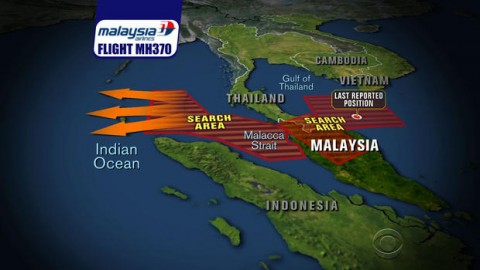Two communications systems on board the missing Malaysian Airlines plane were shut down separately, CBS News confirmed Thursday, a development that suggests the systems were deliberately turned off.
CBS News correspondent Bob Orr reported the two systems used to track Flight 370 were shut down sequentially, just before the Boeing 777 apparently changed course and turned west.
While that could suggest a deliberate act, CBS News aviation and safety expert Capt. Chesley “Sully” Sullenberger cautioned that it is “conceivable” that the communications systems could shut down sequentially on their own in the event of a catastrophic electrical failure. He said the systems in a plane are so compartmentalized that things could shut down in a cascading, domino fashion instead of all at once.
Still, Sullenberger — who gained fame for landing US Airways Flight 1549 safely on the Hudson River in New York City in 2009 — acknowledged that is a remote possibility.
Malaysia Airlines Flight 370 was en route from Kuala Lumpur to Beijing with 239 people on board when it disappeared early on Saturday. After days of hunting for the missing plane, authorities expanded the search west toward India on Thursday, saying the plane may have flown for several hours after its last contract with air traffic control.
There are technical indicators suggesting the plane continued to fly for an unspecified period of time after civilian air traffic controllers lost radar contact with the jet, Orr said.
Sources said the Boeing 777 continued to attempt to transmit routine data about the plane’s engines and performance to satellites. Malaysian authorities and Boeing apparently did not downlink the data, so details from plane’s transmissions are not known.
But the fact that the jet was continuing to send signals is a strong indication that it did not crash immediately after radar contact was lost. The engines instead continued to run, Orr reported, meaning the plane continued in flight or perhaps was on the ground but still producing power.
In addition, U.S. radar experts have looked at the Malaysian military radar track, which seemed to show the jet flying hundreds of miles off course west of its flight path, and back across the Malay Peninsula. Sources said the radar appears to be legitimate and there is a strong reason to suspect that the unidentified blips – seen on military controller screens – are images of Flight 370.
All of this, Orr said, leads to the possibility that the jet flew for hours toward the Indian Ocean. And it is the reason the search field has expanded in that direction.
That scenario would make finding the Boeing 777 a vastly more difficult task, and raises the possibility that searchers have spent days looking in the wrong place for the plane.
India said its navy, air force and coast guard were looking for the missing plane after it received a formal request for help from the Malaysian government.
In the latest in a series of false leads in the hunt, search planes were sent Thursday to search an area off the southern tip of Vietnam whereChinese satellite images published on a Chinese government website reportedly showed three suspected floating objects.
They saw only ocean.
“There is nothing. We went there, there is nothing,” said acting Malaysian Transport Minister Hishammuddin Hussein.
Compounding the frustration, he later said the Chinese Embassy had notified the government that the images were released by mistake and did not show any debris from Malaysia Airlines Flight 370.
The plane left Kuala Lumpur and was flying northeast across the Gulf of Thailand and into the South China Sea when it dropped off civilian radar without any indication it was having any technical problems.

 JOIN DRIVERN TAXI AS PARTNER DRIVER TODAY!
JOIN DRIVERN TAXI AS PARTNER DRIVER TODAY!










